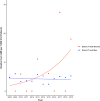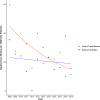Temporal trends in mortality and provision of intensive care in younger women and men with acute myocardial infarction or stroke
- PMID: 36635740
- PMCID: PMC9835383
- DOI: 10.1186/s13054-022-04299-0
Temporal trends in mortality and provision of intensive care in younger women and men with acute myocardial infarction or stroke
Abstract
Background: Timely management of acute myocardial infarction (AMI) and acute stroke has undergone impressive progress during the last decade. However, it is currently unknown whether both sexes have profited equally from improved strategies. We sought to analyze sex-specific temporal trends in intensive care unit (ICU) admission and mortality in younger patients presenting with AMI or stroke in Switzerland.
Methods: Retrospective analysis of temporal trends in 16,954 younger patients aged 18 to ≤ 52 years with AMI or acute stroke admitted to Swiss ICUs between 01/2008 and 12/2019.
Results: Over a period of 12 years, ICU admissions for AMI decreased more in women than in men (- 6.4% in women versus - 4.5% in men, p < 0.001), while ICU mortality for AMI significantly increased in women (OR 1.2 [1.10-1.30], p = 0.032), but remained unchanged in men (OR 0.99 [0.94-1.03], p = 0.71). In stroke patients, ICU admission rates increased between 3.6 and 4.1% per year in both sexes, while ICU mortality tended to decrease only in women (OR 0.91 [0.85-0.95, p = 0.057], but remained essentially unaltered in men (OR 0.99 [0.94-1.03], p = 0.75). Interventions aimed at restoring tissue perfusion were more often performed in men with AMI, while no sex difference was noted in neurovascular interventions.
Conclusion: Sex and gender disparities in disease management and outcomes persist in the era of modern interventional neurology and cardiology with opposite trends observed in younger stroke and AMI patients admitted to intensive care. Although our study has several limitations, our data suggest that management and selection criteria for ICU admission, particularly in younger women with AMI, should be carefully reassessed.
Keywords: Cardiovascular diseases; Critical care; Gender bias; Gender gap; Mortality trend; Sex disparities.
© 2023. The Author(s).
Conflict of interest statement
CG has received speakers’ fees from Sanofi Genzyme, travel support from Siemens Health engineers, and research support from the Novartis Foundation, Switzerland, Bayer Pharmaceuticals, and Gerresheimer AG, Switzerland. The Department of Nuclear Medicine, University Hospital Zurich, holds a research contract with GE Healthcare.
Figures




References
-
- Townsend N, Wilson L, Bhatnagar P, Wickramasinghe K, Rayner M, Nichols M. Cardiovascular disease in Europe: epidemiological update 2016. Eur Heart J. 2016;37(42):3232–3245. - PubMed
-
- Koton S, Schneider AL, Rosamond WD, Shahar E, Sang Y, Gottesman RF, et al. Stroke incidence and mortality trends in US communities, 1987 to 2011. JAMA. 2014;312(3):259–268. - PubMed
-
- Wang Y, Zhou L, Guo J, Wang Y, Yang Y, Peng Q, et al. Secular trends of stroke incidence and mortality in China, 1990 to 2016: the global burden of disease study 2016. J Stroke Cerebrovasc Dis. 2020;29(8):104959. - PubMed
MeSH terms
LinkOut - more resources
Full Text Sources
Medical
Miscellaneous

